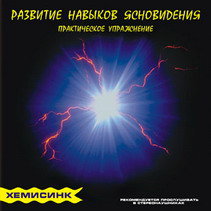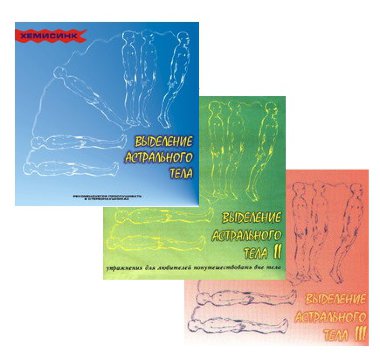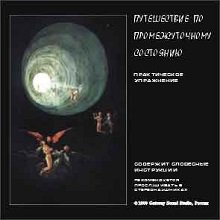Mon—Fri 11:00—17:00 Sat. 12:00—16:00

Description
The disc format .mp3 (192 kbs)
Dreams is a bright mystery still remains unsolvable in modern science. Because in dreams people come into contact with areas of the spirit that are beyond the scope of knowledge of gross materialism.
However, with ancient methods from "inside" to explore the nature of sleep and dreams and gain control over them. That is, to turn your dreams ofunconsciouslyinlucid.
In recent years, our country has issued many works on the practicelucid dreamingsome of which are given in the Appendix. This course is a modest addition to the books of these outstanding masters.
When writing course used technology of "X-sync", allowing to simulate the human brain in different phases of sleep by listening through stereo headphones specific sound signals.
Reminder for incoming classes
What you must have to practice on this course:
- Good stereo headphones. Preferably "large" covering the ears completely. But if You are used to sleep on your side, you can use the "pill" (tiny headphones that are inserted in the ears). If You decide to use a "pill", it makes sense to consult with a specialist about the choice of their models, because they have, on average, less acceptable technical data compared to closed headphones. Whatever it was, the chosen model should be well to reproduce low audio frequencies (30 Hz). Do not skimp on headphones!
- A device for listening to mp3.
- Commitment to achieve stable results.
Remember that success in the practice of lucid dreaming depends on (a) Yourintentionsand (b) from Yourperseverance. Don't despair if you don't get everything at once. At first, You may begin to remember your dreams — it is a favorable sign. Don't leave the practice under any pretext — and You will succeed!
It is very important to have a strongthe intentionthat is deepemotionalinterest. For example, a person may forget to call work to his wife, but it is unlikely he would have forgotten to do this a few years ago, when she was still his girlfriend. The reason is the level of experience of emotions in relation to the result. It is useful to have a little free time before going to sleep to mentally prepare yourself for new adventures. It is also good to write on a blank sheet of paper the desired scenario of your sleep — it will help to give the events more predictable.
Keep a dream journal. It will help to analyze the patterns of Your dreams and watch them change over time, thus helping keep track of your progress in practice! This is useful in solving everyday problems.
Night human sleep is divided into cycles lasting about 90 minutes. Each cycle in turn is subdivided into phases, which, adjusted for not exactly scientific terminology, can be described as follows:
1. Light sleep
2. The deep (orslow) sleep
3. Dreaming (akaquicksleep, aka REM sleep)
In the first cycle of the sleep phase with dreaming only lasts a few minutes. With each subsequent cycle, its duration increases. The duration of deep sleep decrease with each cycle. As the aging relative proportion of deep sleep and dream sleep is reduced.
The course consists of 4 exercises, with a duration of approximately 90 minutes each, the first three of which contain verbal instructions, and the latter does not. Usually used for classes the evening before going to sleep, but there may be individual deviations from this recommendation (because of the nature of Your regime or physiology).
Exercise 1 (track#1):
introduces the phases of sleep. You will learn quickly and deeply to relax, sinking into a state known ashypnagogic. Robert Monroe called it "focus 10". It is accompanied by rich visual and auditory images, and most people pass through it before loss of consciousness when falling asleep.
But the technology is "X-sync" helps You keep this awareness, initially at least slightly longer than usual. First comes the rain, followed the instructions, reinforcing Your intention. Then You will gradually sink into the 3rd and 4th phase of sleep, known as deep, orslowsleep. Here, there is also the sound of rain and instructions. The signal "X-sync" will begin to awaken Your brain activity corresponding tothe stage of dreams(or REM sleep), accompanied by a reminder "You are dreaming". This will happen about 1 hour and 26 minutes from the beginning of phonogram. After a few minutes, special signals will Wake You up completely. Don't forget after this to describe their experiences in the dream journal.
Comment: Work on this exercise until you learn at least a few minutes to maintain awareness in the hypnagogic state.
Exercise 2(track#2):
the process of relaxation and immersion into "focus 10" is faster and is reduced to simple counting from 1 to 10. Then under the rain You mentally envision a dream scenario of using the rain as an element, a starting point. For example, You just walking in the Park in the rain or watching the rain from the window, or something more intricate — let your imagination run free. At this point it is important to recreate the fullness of the experiences accompanying draw You a mental picture.
Then again, You are immersed inslow phaseat the right time and get the reminder: "now You're dreaming." Awakening tones at the end of this exercise, no. Working signals of the "X-sync" gradually fade, and then You can decide: either continue to dream or stand up and make entries in the dream journal.
Note: ideally, this exercise should work until they achieve at least a glimmer of awareness in a dream. Again, we recommend that you record your experiences in a journal.
Exercise 3(track#3):
means that starting to him have already achieved the first positive results in a lucid dream. It remains to build on the success by making the results stable. Main assistant here — perseverance and intention.
In the third exercise, You are full master of the world of their dreams. Unlike the first two, here there is no rain, and draw You in "focus 10" the script is not particularly attached to him. Keeping the script in memory, You, as before, immersed inslow sleepand at the end of the exercises,the stage of dreamsget the hint ("You are dreaming").
Note: If after a long time of this activity You failed to achieve any stable results, try to use one of the following recommendations:
1. Listen to the drive at a different time of day. Some people night is physiologically necessary for rest and recuperation.
2. Go back to exercises 1 and 2. Mental practice — not the sphere of activity, where useful cavalry attack.
3. Try activity 4. Maybe without words it will be better...
Exercise 4(track#4):
here are almost no (except the hint at the end) verbal instructions, and other background sounds — only signals the "X-sync". You do everything yourself: dive into "focus 10", drawing the scenario of the dream, the awareness stage of dreams.
Questions and answers
After the exercises of this Course I Wake up feeling tired. What's the matter?
To maintain the mindfulness You make effort, no matter how insignificant it may seem. So Your body reacts accordingly, though physically You are in a passive state. Try to create for Course a different time of day. In addition, experience shows that over time the body adapts, and the phenomenon of a type of fatigue or drowsiness disappear, regardless of the time listening.
For a long time of the exercises of the Course I only had a few lucid episodes in dreams. ...???
Each person has their own pace of advancement in practice. But sooner or later perseverance and intention will bear fruit.
Is a lucid dream from outside of the bodily experience, or is it the same thing?
Some researchers (for example, Stephen Laberge) consider the WTO a kind of lucid dream. Robert Monroe believed that they are different things. The point here is just the breadth of the definition of the term "beyond bodily experience." In contrast to the concept of lucid dreaming, more or less standardized in modern psychology, the concept of "beyond bodily experience" has no clear definition, because not systematically studied by classical science. If you take the point of view of the Monroe Institute on the WTO as "any experience of consciousness separated from the physical body", then lucid dreaming is a kind of WTO. But not every WTO can be seen as a lucid dream.
I don't dream. Will it help me "Course in lucid dreaming"?
Of course. Most likely, Your problem is not the absence of dreams as such (which is extremely rare due to certain diseases), but the fact that You don't remember. The course will help to solve this problem.
I have episodes of lucidity in dreams, but I quickly lose it. What's your recommendation?
Emotional high that accompanies gaining lucidity in sleep causes some people to awaken. Others, on the contrary, after some time, again fall into unconscious sleep. In both cases, to gain stability they need to practice. Try again back to activity 1, or use other methods to strengthen the intention.
I believe that we have achieved great results in the practice of lucid dreaming. Should I continue to work with the Course?
These exercises — only a training tool. If You have achieved the desired results, you can continue to choose methods of improvement.
Conclusion
Lucid dreaming is an ancient practice that allows to develop spiritually to any person in today's society. With the right approach, it can radically transform Your life. Deliverance from nightmares, mental and physical improvement, find innovative solutions, creative problem solving, finally, just having fun are just some of the possible applications.
I hope You see it for yourself. Good luck!
App
Recommended literature on the practice of lucid dreaming (in Russian)
Tenjin Wangyal Rinpoche:"Tibetan yoga of sleep and dreams", "Karma Yeshe Paldron", SPb. 1999.
Namkhai Chogyal Norbu Rinpoche:"Dream yoga and the practice of natural light".
Stephen Laberge, Howard Rheingold:"Exploring the world of lucid dreaming", Izd-vo Transpersonal Institute, Moscow, 1995;"Practice lucid dreaming", Izd-vo Transpersonal Institute, Moscow, Sofia, Kiev, 1996)
Stephen Laberge:"Lucid dreaming", Izd-vo Transpersonal Institute, Moscow, Sofia, Kiev, 1996.







